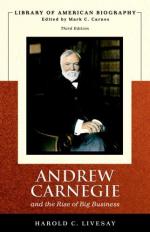
|
| Name: _________________________ | Period: ___________________ |
This test consists of 15 multiple choice questions and 5 short answer questions.
Multiple Choice Questions
1. With whom does Carnegie form Columbia Oil Company?
(a) Wilson Coleman.
(b) William Coleman.
(c) Willard Coleman.
(d) Wallece Coleman.
2. Carnegie presents the bonds to the Morgan investment banking house in London in March, 1869, where he sells them to Morgan at what percent?
(a) 55.
(b) 75.
(c) 85.
(d) 65.
3. Railroad receipts increase from $40 million in 1851 to _____________ fifteen years later in 1867.
(a) $3 billion.
(b) $334 million.
(c) $3.4 milion.
(d) $34,000.
4. Carnegie's first installment on his one-eighth interest in Woodruff is $217.50 borrowed from the bank. The balance is paid by dividends in the venture's ________ year.
(a) Third.
(b) Second.
(c) First.
(d) Fourth.
5. By ________, the Pennsylvania Railroad runs 3,500 miles of track with 30,000 employees and $61 million invested.
(a) 1860.
(b) 1865.
(c) 1870.
(d) 1875.
6. When dividend payments stop, Carnegie plans a ________ exit to maximize Pacific's price by speculation that lets the triumvirate cash out and leave the remaining Pacific stockholders to drown.
(a) Four-step.
(b) Three-step.
(c) Two-step.
(d) Five-step.
7. This craft has been practiced by half its 11,000 people since when?
(a) The 18th century.
(b) Medieval times.
(c) The Renaissance.
(d) The 17th century.
8. Previously Margaret Carnegie's sisters, Annie Aitken and Kitty Hogan immigrate in __________, and write of good and bad times there.
(a) 1840.
(b) 1835.
(c) 1845.
(d) 1830.
9. Carnegie promotes expanding with other Pennsylvania-controlled franchises through Scott and assures construction in his contracting business by bartering Pacific stock for construction costs with ___________ exchange rates.
(a) 5 and 7 to one.
(b) 2 and 4 to one.
(c) 3 and 4 to one.
(d) 3 and 5 to one.
10. Carnegie works ___________ years at the Pennsylvania Railroad while he develops managerial skill, economic principles and personal relationships to become a successful manager, capitalist and entrepreneur.
(a) Eighteen.
(b) Fourteen.
(c) Sixteen.
(d) Twelve.
11. What is the town's industry in 1835?
(a) Basket weaving.
(b) Hand weaving.
(c) Knitting.
(d) Silk weaving.
12. Success is due to the first president, ________________, and the superintendent of the western division, Tom Scott, who brings Andrew Carnegie into the modern system of train control.
(a) J. Edgar Johnson.
(b) J. Edgar Hoover.
(c) J. Edgar Smith.
(d) J. Edgar Thomson.
13. Machines begin taking over production with energy from _____________ independent from windmills and waterwheels.
(a) Wood-burning steam boilers.
(b) Electric steam boilers.
(c) Coal-fired steam boilers.
(d) Oil-burning steam boilers.
14. Why does Pullman gives Carnegie enough Pennsylvania stock to collateralize a $600,000 loan?
(a) He trusts Carnegie.
(b) He needs money.
(c) He is ignorant of this poor decision.
(d) He believes it is one of his best ideas.
15. Scott sends Carnegie off to where as a bond salesman with good wishes, a bag of bonds and letters of reference for the St. Louis Bridge Company?
(a) California.
(b) Europe.
(c) Africa.
(d) Asia.
Short Answer Questions
1. He forms an informal investing ____________ with Thomson and Scott.
2. Their town is at one time known as the most radical in the kingdom, as a result of the influence of ______________ who demand concessions from Parliament, primarily political equality.
3. What railroad focuses capital investments that either increase revenue or reduce unit cost to justify them?
4. Carnegie, acting under Scott-Thomson proxies, now owns how much of Pacific and Atlantic for the start-up Keystone Telegraph?
5. During the nineteenth century American railroads are financed by bonds with over ____ percent of their earnings used to pay bond interest.
|
This section contains 497 words (approx. 2 pages at 300 words per page) |

|




